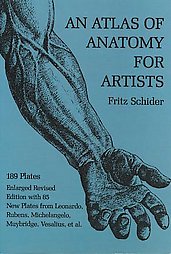I've got some kind of soft spot for old books. This little gem comes from the 1950s and contains the most focused data on the human body I've ever seen. Where a lot of anatomy books are also trying to teach you how to draw, this one could easily be used as a medical reference book.
This is the type of book that reminds me what a professional is, and that there was a time where books were designed to impart unabridged knowledge instead of entertain people.
Give it a look, if you dare. An Atlas of Anatomy for Artists
(This is part 2 of my series on Cognitive dissonance. You can read that one first, or not. I'm not your mother. Now on with the show)
Fresh Eyes
This week I want to talk about the power of sight and the ultimate difference between the artist's ability to see mistakes in a work versus a layman's. I want to cover how it's absolutely legit for anyone to criticize your work and, most of all, why everyone is perfectly qualified.
As a young artist I often struggled with criticism. It frustrated me to no end when someone who couldn't draw their way out of a box would tell me that "something doesn't look right" or ask "what's that supposed to be?" I decided that they didn't know what they were talking about. Besides, I was the artist, right?
So then what happened when my mom introduced me to an artist she knew from work? I received my very first critique, and what do you know, I decided that guy didn't know what he was talking about either. (I was a little jerk back then.)
Here's the paradox: if art is expression, then why couldn't I express myself to these people? Why couldn't they just understand what I was trying to draw? This is the fundamental line that realist illustrators must cross. Unless you intend to only ever express yourself to yourself, at some point you will need to come to terms with the fact that people other than yourself are going to be viewing your work. If it doesn't look right to them, then what difference does it make what you were trying to draw?
So, how is it that anyone with eyes and a brain can tell you something's wrong with your work? Well, it turns out the visual memory system held by an artist is the same as everyone else's. We all know what a car, face, or tree looks like. The difference between the two brains comes in when we look at the connections that take place between normally isolated parts of the brain such as the visual memory (occipital lob) and motor functions (parietal lobe). We can all remember what an object looks like, but it takes a skilled artist to turn that visual memory into a drawing. If a drawing doesn't look "believable," it's simply comes down to the artist's ability to represent something that looks true to everyone's visual memory.
When someone with fresh eyes takes a look at your art, their brain is on overdrive trying to recognize what they're looking at. If it doesn't match the shapes that are embedded in their visual memory, then they'll never think it looks believable. It's our job to create work the visual associations of the brain can grab on to.
So listen to people who say something doesn't look right no matter who they are (at the very least, take it into consideration). Though it takes a pro artist to tell you how you can fix your work, it doesn't take one to tell you your work needs improvement.
Nowadays, I frequently ask my friends and family to tell me if things look right. When you get too close to the art, it's nice to have a fresh pair of eyes to double-check your work. Because, it turns out, that's who we're making this stuff for anyway...
All those fresh eyes out there.
 |
| I'm currently learning how to render in 3D. It's just about as complicated as it looks. |
 |
| Quick sketches for the next in the WMD mechanic series. |
 |
| quick sketch/ challenge to use the fewest brushstrokes possible |

No comments:
Post a Comment